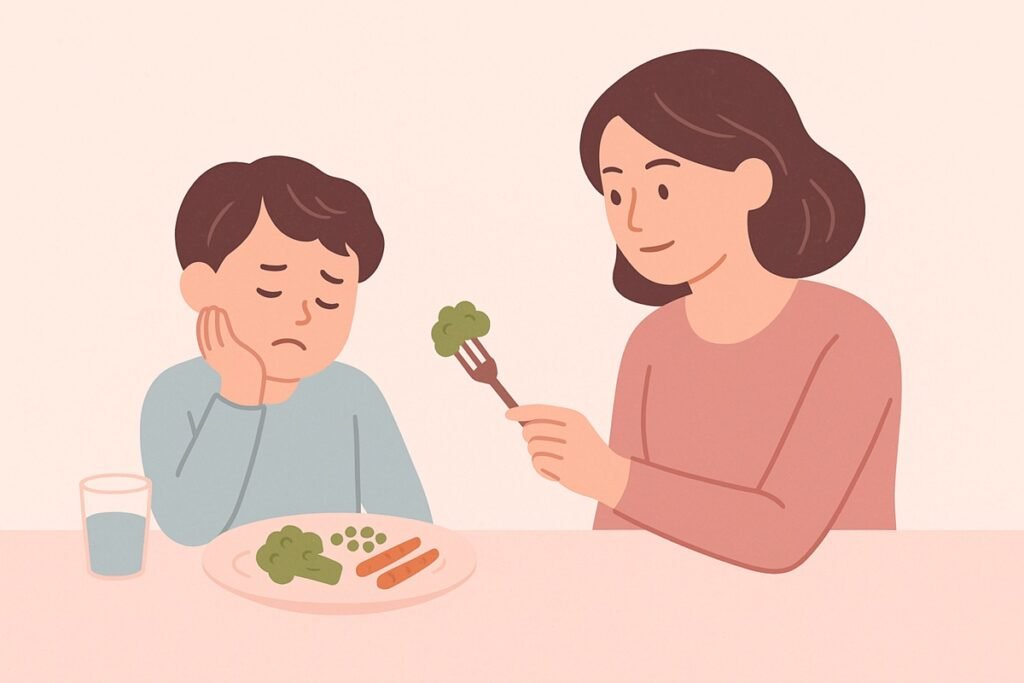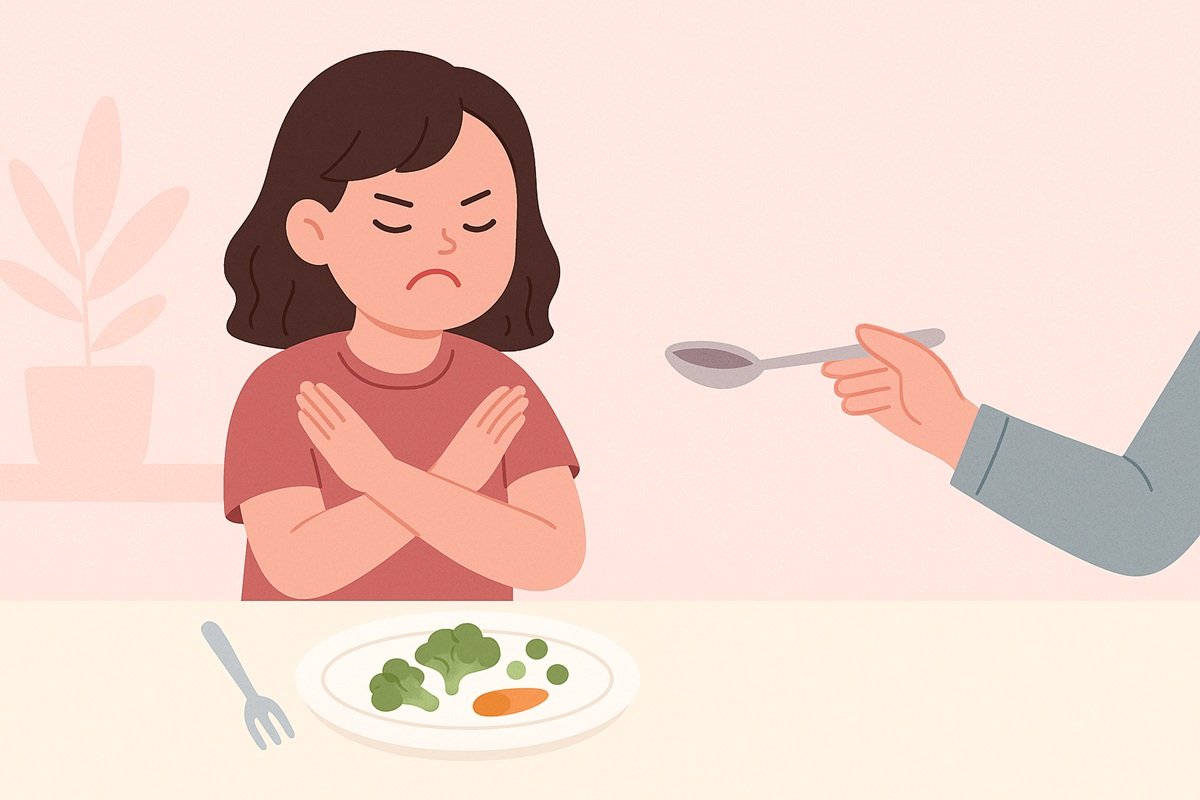Disclaimer: This article reflects the general opinion of a medical professional and is not a substitute for medical consultation. All dietary interventions, medications, or medical tests should be administered only under the supervision of qualified healthcare personnel. Always consult your child’s pediatrician or a registered dietitian before making significant changes to their diet.
Picky eating is a common concern among first-time parents, especially during the toddler and early childhood years. Nutrition Reviews estimates that about 22% of children show signs of picky eating. While it often stems from normal developmental behavior, in some cases, it may point to underlying medical or psychological issues. Moreover, it can lead to serious medical conditions, especially in extreme cases when children fail to consume the nutrients and calories that are needed for healthy development and growth.
This article aims to provide 20 actionable tips for parents of picky eaters while offering insight into when picky eating may warrant deeper medical attention. In addition, this offers a list of healthy foods that a typical picky eater tends to prefer.
Table of Contents
Understanding the Causes of Picky Eating
Before diving into strategies, it’s essential to understand what causes some toddlers and children to become picky eaters.
The main reasons behind this widespread phenomenon, especially among young children, are:
- Developmental Stage: Toddlers are exploring autonomy and often express control through eating behaviors. Refusing food is a natural part of asserting independence.
- Sensory Sensitivities: Some children are hypersensitive to textures, tastes, smells, or colors, making certain foods unpleasant or overwhelming.
- Medical Conditions: Issues like gastroesophageal reflux disease (GERD), food allergies, diarrhea, constipation, or oral motor delays can lead to food refusal.
- Psychological Factors: Anxiety, previous negative food experiences (such as choking or vomiting), or family mealtime stress may contribute.
- Environmental Influence: Inconsistent meal routines, frequent snacking, or pressure at mealtime can reinforce picky behaviors.
When Picky Eating Becomes a Problem

While being a picky eater is not necessarily classified as an eating disorder, there are cases when it can be a dangerous behavior that requires medical attention.
Many children outgrow picky eating, but the following signs may indicate a deeper issue that needs attention:
- Failure to gain weight or grow appropriately
- Avoiding entire food groups (for example, all proteins or all vegetables)
- Mealtimes filled with distress, gagging, or vomiting
- Feeding difficulties that persist beyond age 5
- Nutritional deficiencies diagnosed by a physician
While there is no picky eater test to know whether your child falls under this, if any of the above are present, consult your child’s pediatrician. Further evaluation may be necessary to avoid serious problems.
Medical Tests and Interventions for Chronic Picky Eaters
If a physician suspects a medical cause, some of the following evaluations may be recommended:
- Growth Chart Assessment to monitor weight and height
- Iron, Vitamin D, and B12 Levels for nutritional deficiencies
- Allergy Testing (blood tests or skin pricks) to rule out food allergies
- Swallow Study or Speech Evaluation for oral motor issues
- GI Evaluation if reflux, constipation, or digestive concerns are suspected
- Pediatric Feeding Therapy with occupational or speech therapists
20 Practical Tips for Parents of a Picky Eater
Coping with a picky eater requires a lot of consistency and patience. I know from personal experience that it can be a really trying experience for parents. My wife and I used to think that our first son – Adam – was a picky eater until our second son – Jude – survived for two whole years on sandwiches with cream cheese and sliced apples with occasional indulgence into tomatoes, cucumbers, and potatoes.
Nevertheless, there are certain things that you can adopt into your parenting style to navigate your child’s relationship with food and make them less picky.
Here are 20 proven strategies to try with your picky eater:
- Establish a Routine: Children thrive on routine including when it comes to food. Serve meals and snacks at the same times each day to build appetite regulation.
- Limit Grazing: Avoid constant snacking or drinking milk/juice between meals. It suppresses appetite during main meals.
- Keep Portions Small: Serve tiny portions to avoid overwhelming your child. They can always ask for more.
- Avoid Food Battles: Don’t force bites or bribe with desserts. Mealtime should be low-pressure and positive.
- Offer Variety Repeatedly: Children often need to be exposed to a food 10-15 times before accepting it. Keep offering without pressure.
- Model Good Eating Habits: Eat the same foods together as a family. Children are more likely to try something if they see parents and siblings enjoying it.
- Use Positive Language: Say, “This carrot is sweet and crunchy,” rather than “Eat your vegetables.”
- Get Kids Involved: Have your child help with shopping, washing, and preparing food. Engagement increases curiosity.
- Experiment with Presentation: Use fun shapes, colorful plates, or arrange foods creatively to make them visually appealing.
- Stick to One Meal for the Whole Family: Avoid making separate meals. Offer at least one familiar food your child likes alongside new items.
- Introduce Dips and Spreads: Sometimes hummus, yogurt, or mild dressings make vegetables or proteins more appealing.
- Maintain Neutral Reactions: Whether your child eats or refuses, stay calm. Overreacting can reinforce behavior, while gentle parenting techniques are generally more effective.
- Avoid Distractions: Turn off TVs and tablets during meals. Focused mealtime increases food engagement.
- Respect Appetites: Some days kids are hungrier than others. Trust their ability to self-regulate intake and don’t impose authoritarian parenting behaviors as these are likely to have the opposite effect.
- Avoid Labeling: Don’t call your child a picky eater. Labels can reinforce identity and behavior.
- Gradual Exposure: Let them touch, smell, and taste without expectation. Familiarity reduces fear.
- Set Time Limits: Meals shouldn’t drag on. Allow about 30 minutes, then remove the food calmly.
- Use Non-Food Rewards Wisely: Instead of dessert, offer praise or stickers for trying something new.
- Watch Beverage Intake: Too much milk or juice can reduce hunger. Stick to water between meals.
- Stay Consistent and Patient: Behavior change takes time. Celebrate progress, no matter how small.
For best results, it’s usually a good idea to try a combination of these tips to turn your picky eaters into little gourmets.
Ideas for Healthy Meals for Picky Eaters

While children’s food preferences can be as diverse as it gets, there are certain foods that parents notice to be favored by picky eaters.
Following is a picky eater list of healthy foods by category:
Breakfast Ideas for Picky Eaters
Start the day with energy-boosting meals that are easy to prepare and naturally sweet or familiar in texture.
Some popular favorites include:
- Banana oat pancakes with a drizzle of honey or maple syrup
- Greek yogurt with berries and a sprinkle of granola
- Scrambled eggs with melted cheese, served with toast soldiers
- Smoothies (banana, spinach, and peanut butter is a surprising hit)
- Whole grain mini waffles topped with almond butter and banana slices
Lunch Ideas for Picky Eaters
Lunchtime doesn’t have to mean plain pasta or crackers every day.
Try these instead:
- Turkey and cheese roll-ups (skip the bread if they prefer)
- Hummus and veggie wraps with carrots and cucumbers cut into fun shapes
- Mini quesadillas with melted cheese and hidden veggies like spinach or beans
- Pasta with butter and a sprinkle of parmesan, paired with steamed broccoli on the side
- Hard-boiled eggs with whole grain crackers and a fruit cup
Snack Ideas for Picky Eaters
Keep snacks simple and colorful, and use muffin tins or bento boxes to make them more fun.
Some snacks to try are:
- Apple slices with peanut butter or sunflower butter
- Yogurt tubes or cups with fun toppings like chopped fruit or seeds
- Cheese cubes and whole grain pretzels
- Homemade mini muffins (try zucchini, banana, or pumpkin)
- Sliced cucumber and bell peppers with ranch or hummus dip
Dinner Ideas for Picky Eaters
Dinner is often the hardest for picky eaters – aim for balance, not perfection.
Here are some ideas that are usually well accepted
- Baked chicken nuggets with sweet potato fries
- Mac and cheese made with pureed butternut squash or cauliflower
- Mini meatballs with spaghetti and a side of fruit
- DIY taco bowls (let them choose their toppings)
- Stir-fried rice with scrambled eggs and finely chopped veggies
Foods Picky Eaters Often Like (That Can Be Made Healthy)
Additionally, here are some foods that a picky eater might enjoy that can be made healthy:
- Plain pasta (add hidden veggie sauces)
- Bread and crackers (switch to whole grain or seeded options)
- Cheese (serve with veggies or add to cooked dishes – in moderate amounts)
- Peanut butter (pair with apples, bananas, or oats)
- Chicken nuggets (make baked versions at home)
- Fruit like bananas, apples, strawberries, and seedless grapes
Final Words of Encouragement
For new parents, it can be distressing when your toddler or child refuses to eat. Remember, it’s a phase for many families and not a sign of failure. However, persistent picky eating that affects health and development may require medical attention.
When in doubt, seek support from a pediatrician, registered dietitian, or feeding specialist. With patience, structure, and empathy, many children gradually expand their diets and form healthy relationships with food.
What have your experiences been? Is your child a picky eater? What has worked and what hasn’t? Share your thoughts in the comments.







